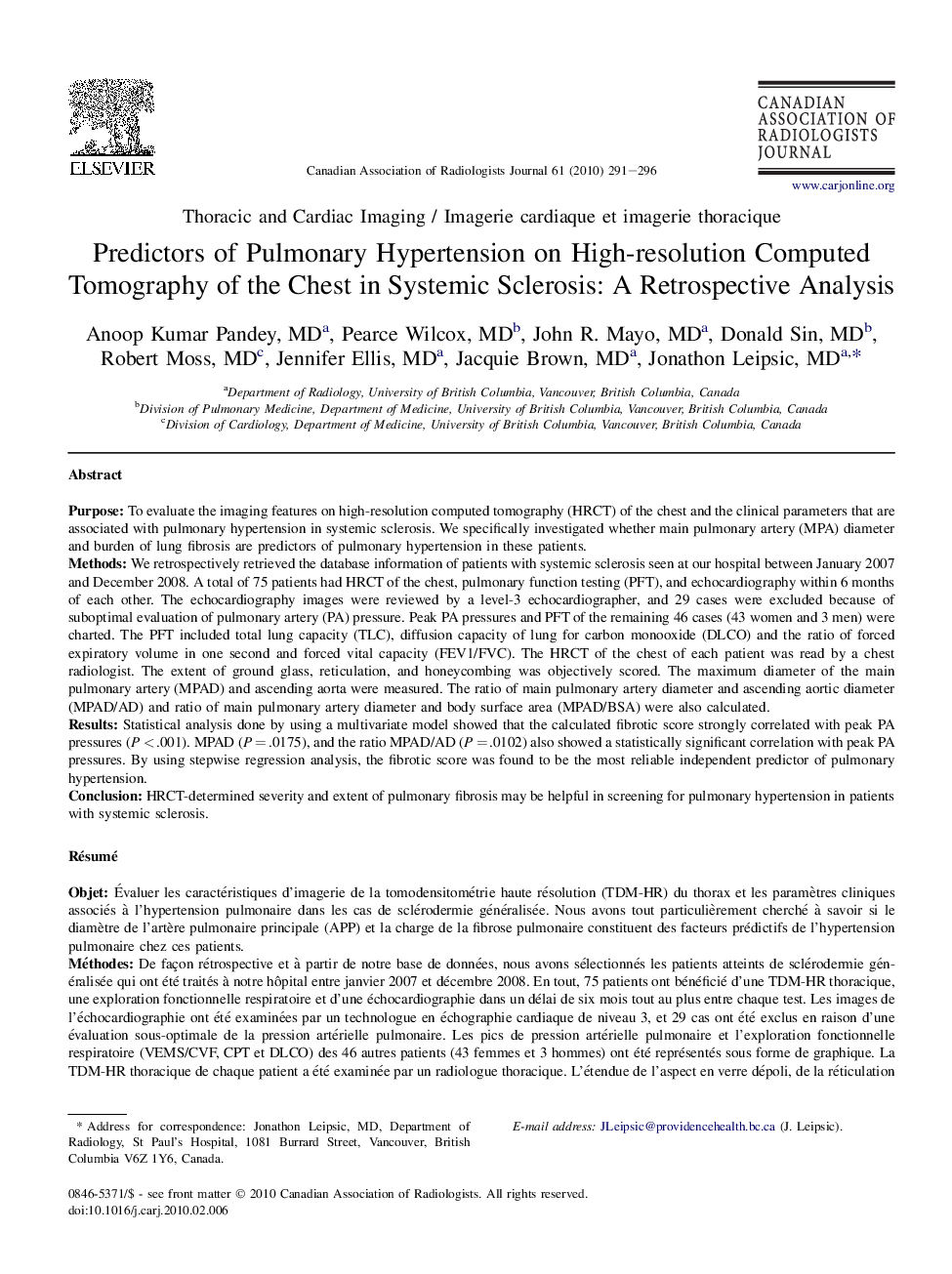| Article ID | Journal | Published Year | Pages | File Type |
|---|---|---|---|---|
| 4220702 | Canadian Association of Radiologists Journal | 2010 | 6 Pages |
PurposeTo evaluate the imaging features on high-resolution computed tomography (HRCT) of the chest and the clinical parameters that are associated with pulmonary hypertension in systemic sclerosis. We specifically investigated whether main pulmonary artery (MPA) diameter and burden of lung fibrosis are predictors of pulmonary hypertension in these patients.MethodsWe retrospectively retrieved the database information of patients with systemic sclerosis seen at our hospital between January 2007 and December 2008. A total of 75 patients had HRCT of the chest, pulmonary function testing (PFT), and echocardiography within 6 months of each other. The echocardiography images were reviewed by a level-3 echocardiographer, and 29 cases were excluded because of suboptimal evaluation of pulmonary artery (PA) pressure. Peak PA pressures and PFT of the remaining 46 cases (43 women and 3 men) were charted. The PFT included total lung capacity (TLC), diffusion capacity of lung for carbon monooxide (DLCO) and the ratio of forced expiratory volume in one second and forced vital capacity (FEV1/FVC). The HRCT of the chest of each patient was read by a chest radiologist. The extent of ground glass, reticulation, and honeycombing was objectively scored. The maximum diameter of the main pulmonary artery (MPAD) and ascending aorta were measured. The ratio of main pulmonary artery diameter and ascending aortic diameter (MPAD/AD) and ratio of main pulmonary artery diameter and body surface area (MPAD/BSA) were also calculated.ResultsStatistical analysis done by using a multivariate model showed that the calculated fibrotic score strongly correlated with peak PA pressures (P < .001). MPAD (P = .0175), and the ratio MPAD/AD (P = .0102) also showed a statistically significant correlation with peak PA pressures. By using stepwise regression analysis, the fibrotic score was found to be the most reliable independent predictor of pulmonary hypertension.ConclusionHRCT-determined severity and extent of pulmonary fibrosis may be helpful in screening for pulmonary hypertension in patients with systemic sclerosis.
RésuméObjetÉvaluer les caractéristiques d'imagerie de la tomodensitométrie haute résolution (TDM-HR) du thorax et les paramètres cliniques associés à l'hypertension pulmonaire dans les cas de sclérodermie généralisée. Nous avons tout particulièrement cherché à savoir si le diamètre de l'artère pulmonaire principale (APP) et la charge de la fibrose pulmonaire constituent des facteurs prédictifs de l'hypertension pulmonaire chez ces patients.MéthodesDe façon rétrospective et à partir de notre base de données, nous avons sélectionnés les patients atteints de sclérodermie généralisée qui ont été traités à notre hôpital entre janvier 2007 et décembre 2008. En tout, 75 patients ont bénéficié d'une TDM-HR thoracique, une exploration fonctionnelle respiratoire et d'une échocardiographie dans un délai de six mois tout au plus entre chaque test. Les images de l'échocardiographie ont été examinées par un technologue en échographie cardiaque de niveau 3, et 29 cas ont été exclus en raison d'une évaluation sous-optimale de la pression artérielle pulmonaire. Les pics de pression artérielle pulmonaire et l'exploration fonctionnelle respiratoire (VEMS/CVF, CPT et DLCO) des 46 autres patients (43 femmes et 3 hommes) ont été représentés sous forme de graphique. La TDM-HR thoracique de chaque patient a été examinée par un radiologue thoracique. L'étendue de l'aspect en verre dépoli, de la réticulation et des images en rayon de miel ont été notée de façon objective. Le diamètre maximal de l'APP et de l'aorte ascendante a été mesuré. Les ratios APP/aorte et APP/surface corporelle ont également été calculés.RésultatsL'analyse statistique effectuée à l'aide d'un modèle multivarié a démontré qu'il existait une forte corrélation entre le score de fibrose calculé et les pics de pression artérielle pulmonaire (P < 0,001). Le diamètre de l'APP (P = 0,0175) et le ratio APP/aorte (P = 0,0102) ont eux aussi montré une corrélation statistiquement importante avec les pics de pression artérielle pulmonaire. À la suite d'une analyse par régression pas à pas, nous avons constaté que le score de fibrose constitue le facteur prédictif le plus fiable d'hypertension pulmonaire.ConclusionL'évaluation de la gravité et de l'étendue de la fibrose pulmonaire grâce à la TDM-HR peut se révéler utile aux fins du dépistage de l'hypertension pulmonaire chez les patients atteints de sclérodermie généralisée.
